Android的六大布局
LinearLayout(线性布局)、RelativeLayout(相对布局)、GridLayout(网格布局)、FrameLayout(帧布局)、TableLayout(表格布局)、AbsoluteLayout(绝对布局)。此外还有ConstraintLayout(约束布局)这种新型布局。
学习布局的基础概念图
(一)Android布局管理器的类图

上面这个类图只是说了六大基本布局的关系,其实ViewGroup还有其他一些布局管理器。
这里要理解一点就是布局也是布局管理器,因为布局里面还可以添加布局。
(二)Android布局的XML关系图

局管理器里面既可以添加多个布局管理器又可以添加多个控件,而控件里面不能在添加布局或控件了。
布局类型及其具体介绍


1、LinearLayout布局
- 布局特点:放主要提供控件水平或者垂直排列的模型,每个子组件
都是以垂直或水平的方式来线性排布.(默认是垂直)。 应用场景:最常用的布局方式
布局方式:android:orientation=”horizontal” (水平) android:orientation=”vertical” (垂直)
<?xml version="1.0" encoding="utf-8"?>
<LinearLayout
xmlns:android="http://schemas.android.com/apk/res/android"
android:layout_width="match_parent"
android:layout_height="match_parent"
android:orientation="vertical">
<LinearLayout
android:layout_width="match_parent"
android:layout_height="250dp"
android:orientation="horizontal">
<TextView
android:layout_width="96dp"
android:layout_height="match_parent"
android:background="#b2dfdb" />
</LinearLayout>
<LinearLayout
android:layout_width="match_parent"
android:layout_height="match_parent"
android:orientation="vertical">
<TextView
android:layout_width="match_parent"
android:layout_height="68dp"
android:background="#b2dfdb" />
</LinearLayout>
</LinearLayout>结果截图:
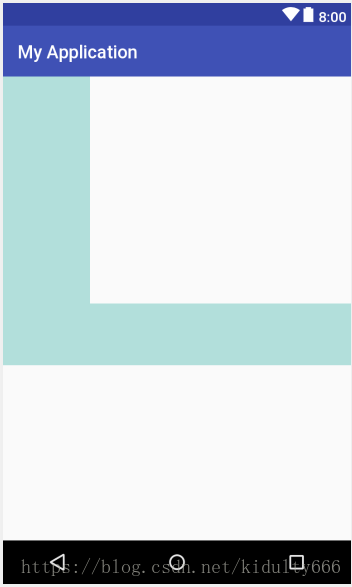
2、RelativeLayout布局
- 布局特点:为某一个组件为参照物,来定位下一个组件的位置的布局方式。
- 应用场景:控件之间存在相应关系(适配神器,推荐使用)
- 常用属性:
1、相对于父控件,例如:android:layout_alignParentTop=“true”
android:layout_alignParentTop 控件的顶部与父控件的顶部对齐;
android:layout_alignParentBottom 控件的底部与父控件的底部对齐;
android:layout_alignParentLeft 控件的左部与父控件的左部对齐;
android:layout_alignParentRight 控件的右部与父控件的右部对齐;
2、相对给定Id控件,例如:android:layout_above=“@id/**”
android:layout_alignBaseline 控件的baseline与给定ID的baseline对齐;
android:layout_below 在某元素的下方
android:layout_above 在某元素的上方
andorid:layout_toRightOf 在某元素的右方
android:layout_toLeftOf 在某元素的左方
android:layout_alignBottom 和某元素下方对齐
android:layout_alignTop 和某元素上方对齐
android:layout_alignRight 和某元素右方对齐
android:layout_alignLeft 和某元素左方对齐
3、居中,例如:android:layout_centerInParent=“true”
android:layout_centerHorizontal 水平居中;
android:layout_centerVertical 垂直居中;
android:layout_centerInParent 父控件的中央;
4、边距,例如:android:layout_margin=” xxdp”
android:layout_marginLeft 离某元素左边缘的距离
android:layout_marginRight 离某元素右边缘的距离
android:layout_marginTop 离某元素上边缘的距离
android:layout_marginBottom 离某元素下边缘的距离
使用示例:
<RelativeLayout xmlns:android="http://schemas.android.com/apk/res/android"
xmlns:tools="http://schemas.android.com/tools"
android:layout_width="match_parent"
android:layout_height="match_parent"
>
<TextView
android:id="@+id/main_tv_title"
android:layout_width="match_parent"
android:layout_height="wrap_content"
android:background="#55ff0000"
android:gravity="center"
android:text="相对布局的使用" />
<!--
android:layout_alignParentBottom="true"位于父框架的底部
android:layout_centerHorizontal="true"在父框架中水平居中
android:layout_centerVertical="true"在父框架中垂直居中
这两个要区分,一个是边界对齐,一个是位于哪个方位
android:layout_below="@+id/main_tv_title"位于对应文件的下边
android:layout_alignRight="@+id/main_tv_title"和对应文件右对齐 -->
<TextView
android:id="@+id/main_tv_title2"
android:layout_width="wrap_content"
android:layout_height="wrap_content"
android:layout_alignLeft="@+id/main_tv_title"
android:layout_below="@+id/main_tv_title"
android:background="#5500ff00"
android:text="二级标题" />
<TextView
android:id="@+id/main_tv_center"
android:layout_width="wrap_content"
android:layout_height="wrap_content"
android:layout_centerInParent="true"
android:text="中间"
android:textSize="22sp"
android:layout_margin="30dp" />
<TextView
android:id="@+id/main_tv_up"
android:layout_width="wrap_content"
android:layout_height="wrap_content"
android:layout_above="@id/main_tv_center"
android:layout_alignRight="@id/main_tv_center"
android:text="上面"
android:textSize="22sp" />
<TextView
android:id="@+id/main_tv_dowm"
android:layout_width="wrap_content"
android:layout_height="wrap_content"
android:layout_alignRight="@id/main_tv_center"
android:layout_below="@id/main_tv_center"
android:text="下面"
android:textSize="22sp" />
<TextView
android:id="@+id/main_tv_left"
android:layout_width="wrap_content"
android:layout_height="wrap_content"
android:layout_toLeftOf="@id/main_tv_center"
android:text="左边"
android:layout_alignTop="@id/main_tv_center"
android:textSize="22sp" />
<TextView
android:id="@+id/main_tv_right"
android:layout_width="wrap_content"
android:layout_height="wrap_content"
android:layout_toRightOf="@id/main_tv_center"
android:layout_alignTop="@id/main_tv_center"
android:text="上面"
android:textSize="22sp" />
</RelativeLayout>结果截图:
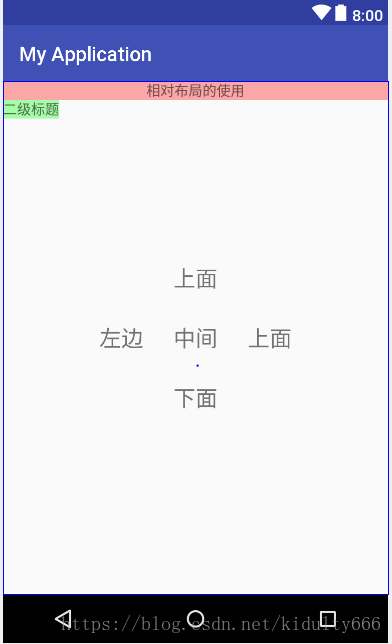
3、FrameLayout
- 布局特点:放入其中的所有元素都被放置在最左上的区域,而且无法为这些元素指定一个确切的位置,下一个子元素会重叠覆盖上一个子元素。
- 应用场景:适合浏览单张图片。
使用示例:
<?xml version="1.0" encoding="utf-8"?>
<FrameLayout xmlns:android="http://schemas.android.com/apk/res/android"
android:layout_width="match_parent"
android:layout_height="match_parent" >
<TextView
android:layout_width="300dp"
android:layout_height="300dp"
android:background="#f00"
android:layout_gravity="center"
/>
<TextView
android:layout_width="200dp"
android:layout_height="200dp"
android:background="#0f0"
android:layout_gravity="center"
/>
<TextView
android:layout_width="100dp"
android:layout_height="100dp"
android:background="#00f"
android:layout_gravity="center"
/>
<TextView
android:layout_width="50dp"
android:layout_height="52dp"
android:layout_gravity="center"
android:background="#fff" />
<TextView
android:layout_width="20dp"
android:layout_height="wrap_content"
android:layout_gravity="center"
android:background="#000" />
</FrameLayout>结果截图:
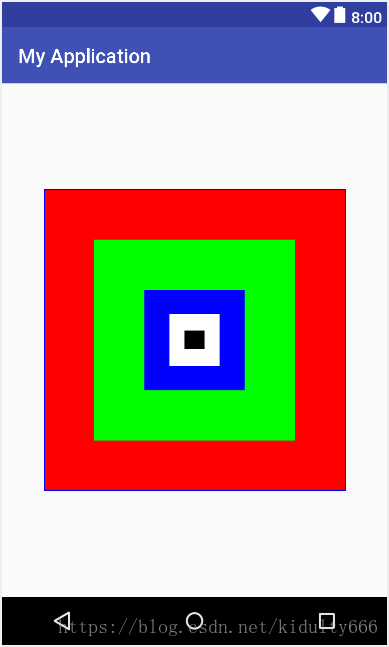
4、TableLayout布局
- 布局特点:类似Html里的Table.使用TableRow来布局,其中TableRow代表一行,TableRow的每一个视图组件代表一个单元格。
- 应用场景:控件之间存在相应关系。
- TableLayout常用属性:android:shrinkColumns:设置可收缩的列,内容过多就收缩显示到第二行
android:stretchColumns:设置可伸展的列,将空白区域填充满整个列
android:collapseColumns:设置要隐藏的列
列的索引从0开始,shrinkColumns和stretchColumns可以同时设置。 - 子控件常用属性:android:layout_column:第几列
android:layout_span:占据列数
使用示例:
<?xml version="1.0" encoding="utf-8"?><LinearLayout xmlns:android="http://schemas.android.com/apk/res/android"
android:orientation="vertical" android:layout_width="match_parent"
android:layout_height="match_parent">
<LinearLayout
android:layout_width="match_parent"
android:layout_height="50dp"
android:gravity="center">
<TextView
android:layout_width="wrap_content"
android:layout_height="wrap_content"
android:text="首页"/>
</LinearLayout>
<LinearLayout
android:layout_width="match_parent"
android:layout_height="match_parent"
android:layout_weight="1"
android:gravity="center">
<TableLayout
android:layout_width="match_parent"
android:layout_height="match_parent"
android:stretchColumns="0,1,2"
android:gravity="center">
<TableRow>
<TextView
android:layout_width="100dp"
android:layout_height="100dp"
android:layout_margin="5dp"
android:background="#e2a617"
android:text="文件管理"
android:gravity="center"/>
<TextView
android:layout_width="100dp"
android:layout_height="100dp"
android:layout_margin="5dp"
android:background="#0d637f"
android:text="应用商店"
android:gravity="center"/>
<TextView
android:layout_width="100dp"
android:layout_height="100dp"
android:layout_margin="5dp"
android:background="#aa2266"
android:text="文件管理"
android:gravity="center"/>
</TableRow>
<TableRow>
<TextView
android:layout_width="100dp"
android:layout_height="100dp"
android:layout_margin="5dp"
android:background="#45e15f"
android:text="应用管理"
android:gravity="center"/>
<TextView
android:layout_width="200dp"
android:layout_height="100dp"
android:layout_margin="5dp"
android:background="#3924a4"
android:text="应用中心"
android:gravity="center"
android:layout_span="2"/>
</TableRow>
</TableLayout>
</LinearLayout>
<TableLayout
android:layout_width="match_parent"
android:layout_height="55dp"
android:background="#f5f5f5"
android:stretchColumns="0,1,2,3"
android:gravity="center_vertical">
<TableRow>
<TextView
android:layout_width="wrap_content"
android:layout_height="wrap_content"
android:gravity="center"
android:text="首页" />
<TextView
android:layout_width="wrap_content"
android:layout_height="wrap_content"
android:gravity="center"
android:text="消息" />
<TextView
android:layout_width="wrap_content"
android:layout_height="wrap_content"
android:gravity="center"
android:text="发现" />
<TextView
android:layout_width="wrap_content"
android:layout_height="wrap_content"
android:gravity="center"
android:text="我" />
</TableRow>
</TableLayout>
</LinearLayout>
结果截图:
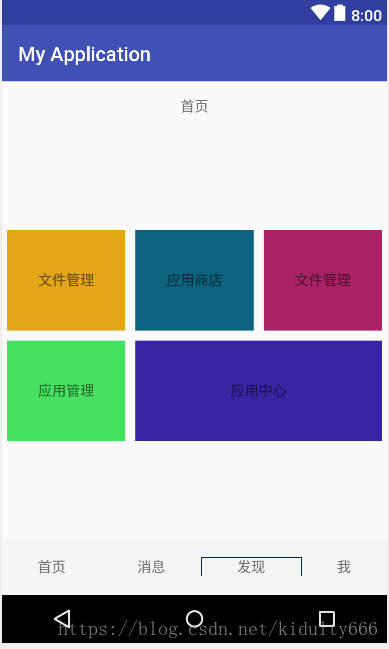
5、AbsoluteLayout布局
- 布局特点:采用坐标轴的方式定位组件,左上角是(0,0)点,往右x轴递增,往下Y轴递增,组件定位属性为android:layout_x和 android:layout_y来确定坐标。
- 应用场景:准确定位空间位置
- 绝对布局中将所有的子元素通过设置android:layout_x 和 android:layout_y属性,将子元素的坐标位置固定下来,即坐标(android:layout_x, android:layout_y) ,layout_x用来表示横坐标,layout_y用来表示纵坐标。屏幕左上角为坐标(0,0),横向往右为正方,纵向往下为正方。实际应用中,这种布局用的比较少,因为Android终端一般机型比较多,各自的屏幕大小。分辨率等可能都不一样,如果用绝对布局,可能导致在有的终端上显示不全等。
使用示例:
<?xml version="1.0" encoding="utf-8"?>
<AbsoluteLayout xmlns:android="http://schemas.android.com/apk/res/android"
android:layout_width="match_parent"
android:layout_height="match_parent" >
<TextView
android:layout_height="wrap_content"
android:layout_width="wrap_content"
android:layout_x="20dp"
android:layout_y="20dp"
android:text="用户名:"
/>
<EditText
android:layout_height="wrap_content"
android:layout_width="200dp"
android:layout_x="80dp"
android:layout_y="7dp"
/>
<TextView
android:layout_height="wrap_content"
android:layout_width="wrap_content"
android:layout_x="20dp"
android:layout_y="80dp"
android:text="密 码:"
/>
<EditText
android:layout_height="wrap_content"
android:layout_width="200dp"
android:layout_x="80dp"
android:layout_y="60dp"
/>
<Button
android:layout_height="50dp"
android:layout_width="100dp"
android:layout_x="90dp"
android:layout_y="120dp"
android:text="提交"
/>
</AbsoluteLayout>结果截图:
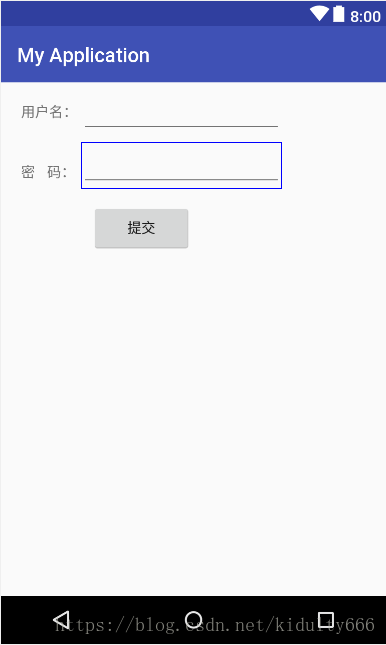
6、RelativeLayout布局
- 布局特点:为某一个组件为参照物,来定位下一个组件的位置的布局方式。
- 应用场景:控件之间存在相应关系(适配神器,推荐使用)
- 常用属性:
- 排列对齐:
①设置组件的排列方式: android:orientation=”” vertical(竖直,默认)或者horizontal(水平)
②设置组件的对齐方式: android:layout_gravity=”” center,left,right,buttom - 设置布局为几行几列:
①设置有多少行: android:rowCount=”4” //设置网格布局有4行
②设置有多少列: android:columnCount=”4” //设置网格布局有4列 - 设置某个组件位于几行几列
注:都是从0开始算的哦!
①组件在第几行: android:layout_row = “1” //设置组件位于第二行
②组件在第几列: android:layout_column = “2” //设置该组件位于第三列 - 设置某个组件横跨几行几列:
①横跨几行: android:layout_rowSpan = “2” //纵向横跨2行
②横跨几列: android:layout_columnSpan = “3” //横向横跨2列
- 排列对齐:
使用示例:
<GridLayout xmlns:android="http://schemas.android.com/apk/res/android"
xmlns:tools="http://schemas.android.com/tools"
android:id="@+id/GridLayout1"
android:layout_width="wrap_content"
android:layout_height="wrap_content"
android:columnCount="4"
android:orientation="horizontal"
android:rowCount="6" >
<TextView
android:layout_columnSpan="4"
android:layout_marginLeft="5dp"
android:layout_marginRight="5dp"
android:text="0"
android:textSize="50sp" />
<Button
android:layout_columnSpan="2"
android:layout_gravity="fill"
android:text="回退" />
<Button
android:layout_columnSpan="2"
android:layout_gravity="fill"
android:text="清空" />
<Button android:text="+" />
<Button android:text="1" />
<Button android:text="2" />
<Button android:text="3" />
<Button android:text="-" />
<Button android:text="4" />
<Button android:text="5" />
<Button android:text="6" />
<Button android:text="*" />
<Button android:text="7" />
<Button android:text="8" />
<Button android:text="9" />
<Button android:text="/" />
<Button
android:layout_width="wrap_content"
android:text="." />
<Button android:text="0" />
<Button android:text="=" />
</GridLayout>结果截图:
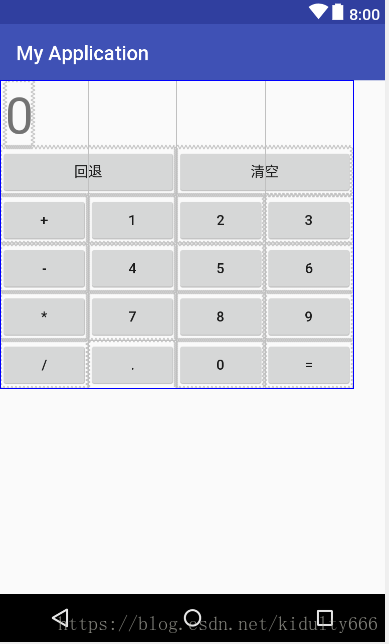




 本文详细介绍了Android开发中常用的六大布局,包括LinearLayout、RelativeLayout、FrameLayout、TableLayout、AbsoluteLayout及GridLayout的特点、应用场景及使用示例。
本文详细介绍了Android开发中常用的六大布局,包括LinearLayout、RelativeLayout、FrameLayout、TableLayout、AbsoluteLayout及GridLayout的特点、应用场景及使用示例。
















 2319
2319

 被折叠的 条评论
为什么被折叠?
被折叠的 条评论
为什么被折叠?








